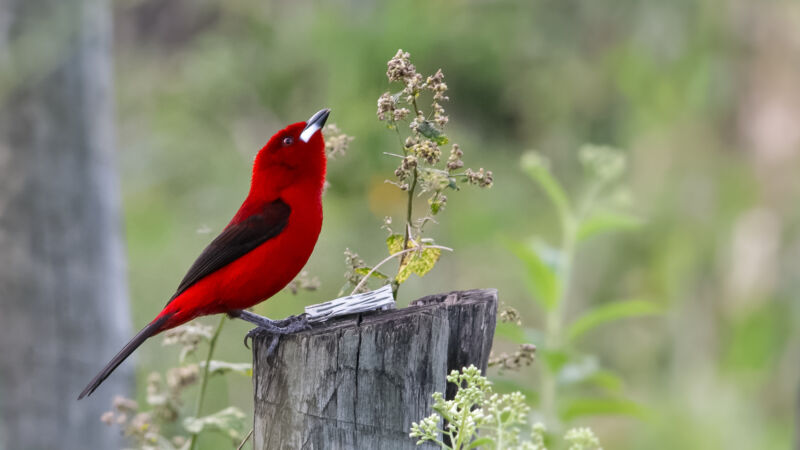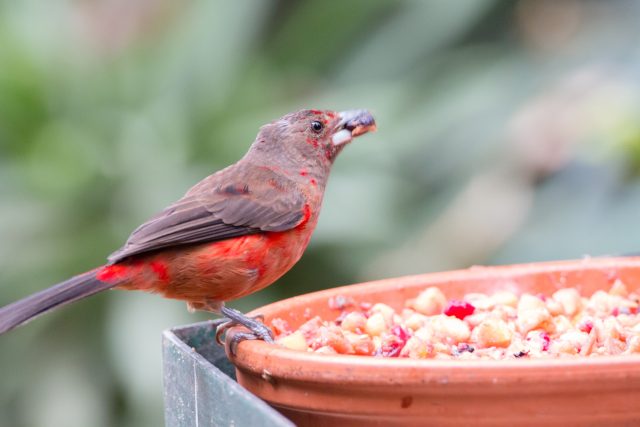Don’t you know that the bird’s the word? —
Male tanager birds have more than one way to make their colors really pop for the ladies.
Matt Simon, wired.com
–

Enlarge / A Brazilian tanager (Ramphocelus bresilius) with his cheating red feathers looking up at the sky.
Rogerio Peccioli | Getty
Female tanager birds dig flamboyant males. So to build plumage that really pops with orange or red or yellow, a male has to eat fruits and absorb their carotenoids. The fancy feathers he produces then serve as an honest signal, in the evolutionary sense, as his ability to consume a lot of carotenoids shows that he’s fit. And the female wants to pass those genes along to her offspring, please and thank you.
Except biologists just discovered that male tanagers seem to be cheating. They’re not necessarily harvesting more carotenoids to gussy up their appearance. Instead, they’re changing the very structure of their feathers to play with light, thus modifying their color. Depending on the species—and the preferences of its females—they can make an ordinary red really glow, or make it more muted and plush. The males can even dial-up the contrast of these color patches by making their surrounding feathers ultra-black with a structure that basically eats light.
“They’re making themselves essentially look brighter and more colorful without necessarily putting in these expensive pigments. So they’re essentially dishonestly signaling their color to females,” says Allison Shultz, curator of birds at the Natural History Museum of Los Angeles, who coauthored a recent paper describing the findings in the journal Scientific Reports.
It’s particularly dishonest because of how indicative carotenoids are of a male’s health; the pigments are also antioxidants, so they’re essential for the bird’s immune system. By allocating them to his feathers instead, he’s essentially saying: Hey, look how healthy I am. “Furthermore, many times they’re not using the same types of carotenoids that they eat,” says Shultz. “They’re actually changing them into another type of carotenoid, and that’s another kind of expensive cost because they have to have enough energy to do this conversion.”
So a colorful male tanager is kind of a big deal. But that may not be enough for the female. I just can’t overstate how much they like colorful males, which puts evolutionary pressure on males to keep upping their color game, generation after generation. Since allocating more pigment to their feathers can only get them so far, they’ve evolved feather microstructures to turbocharge that pigment.
“We actually found that males and females had very similar types and amounts of carotenoids, which frankly was shocking,” Shultz says. Only males, though, have these fancy feather structures.

Enlarge / The female Brazilian tanager lacks the male’s fancy feather structures.
lues01 | Getty
A female’s feather, which is blasé in comparison, consists of filaments called barbules attached to a barb—the stem, basically. But depending on the species, a male tanager’s barbs and barbules exploit different strategies to produce variations of color. (These researchers looked at 10 species in the genus Ramphocelus.) For example, Ramphocelus passerinii’s thicker barb means more color, producing a brighter red. Or a male Ramphocelus carbo has barbules that are angled instead of flat, to decrease the reflectance of the feather by scattering the light that hits it. This results in a subtle, velvety maroon. “It’s combining these different ways to have color in a way that we haven’t seen before in birds,” says Shultz.
The researchers also found this scattering microstructure in the photon-eating black feathers that surround the patch of color. Interestingly enough, one of the coauthors on this new paper described the same kind of microstructures in the ultra-black feathers of birds of paradise, which aren’t related to tanagers. That makes this a case of convergent evolution, or two unrelated groups of animals independently evolving the same trait. (But it’s not the same mechanism used by these ultra-black deep-sea fish, which use their dark pigment to sneak up on prey.)
So whether the species is opting for a bright or muted red, those light-scattering black feathers produce a striking contrast that makes the plumage stand out. “It makes sense once you think about it,” says Jack Dumbacher, curator of birds and mammals at the California Academy of Sciences, who wasn’t involved in the work. “But if somebody tried to tell you this, without all this evidence, you’d be very skeptical. I thought they just did a really nice job of nailing it down.”
Gathering enough carotenoids to both power the male tanager’s immune system and to color himself is of course critical—he needs a palette to start off with. Eating enough carotenoids to perform these basic functions is still acting as an “honest” signal. But by futzing with the structure of the feathers, the male tanager is basically embellishing his dating profile.
Yet, just because the male tanager is cheating doesn’t mean the strategy is cost-free. “I wonder, how does this affect the ability of parasites to attach to feathers, or their ability to repel water?” asks Shultz. “Feathers have many, many different functions. And so signaling is only one of them.”
In some ways, having the excess energy required to develop and maintain those feathers could actually turn out to be an honest signal. It takes protein to build them, and the bird needs to produce oils to keep them in good shape. They require constant pruning, too. So if it turns out that parasites attach more easily to these microstructures, that might mean a male would need to spend even more energy grooming himself. “The fact that you have that time, and you have those oils, and you had the feather in the first place—those might all be honest signals,” says Dumbacher. Basically: not only am I as dapper as I claim in my dating profile, but I’m also free of parasites. Which, swoon.
But why go through all the trouble of evolving elaborate feather microstructures when males already have the pigmentation to signal to females? Well, that’s the literal beauty of evolution. “Evolution is pretty remarkable,” says Shultz. “Males will probably find a way to evolve a means to get around the signal to make themselves look more bright, more elaborate, or fancier, without necessarily putting in the same cost. And so those males are going to get more mates, they’re going to be healthier, so they’re probably going to have more offspring. And so then through natural selection, that’s going to be that trait is going to take over.”
In other words, female tanagers don’t want no scrubs. If a brightly colored male is most likely to be the healthiest, evolutionarily speaking, she wants to give those genes to her own sons. If her sons don’t pop, they don’t reproduce, while someone else’s flashier kids continue their own genetic line. It’s a sort of evolutionary arms race. Females want the fittest males, but males try to game the system. Instead of spending time and energy stuffing himself with more carotenoids from fruits, the male can “cheat” using the microstructures in his feathers. Shultz and her colleagues call this the “proxy treadmill,” in which males develop tricks to signal fitness without necessarily being more fit.
“There’s this treadmill of these proxies that are constantly changing,” says Shultz. “Males and females are in this war over males trying to make themselves look as best they can while putting in the least amount of resources, whereas females want to use traits that are going to actually be indicative of a male’s underlying quality.” A female can’t just abandon her preference for flashier males, because that would doom her sons to being unattractive.
It’s possible that this preference for flashy males first began to evolve in tanagers because they already seek bright colors when searching for food: these clue-in birds to the presence of yummy fruits. “If a male has a really bright red, and females are already turning their head to that color, then it’s going to give him an edge,” says Dumbacher. “Vertebrates do evolve an aesthetic sense. There’s different reasons that females might prefer something. And as long as there isn’t a huge cost to liking that, it can evolve just because the females like it.”
Evolutionary biologists call it a “swipe right.” Or at least they should.
This story originally appeared on wired.com.

